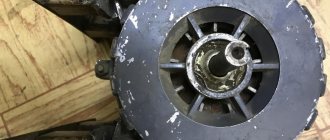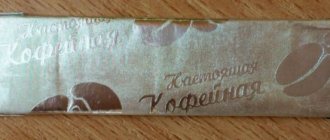The homemade tap holder in question is simple to make and the materials for it are easy to find. If suitable hardware is not in the garage, you can buy them for a small amount. The DIY process will take about half an hour, and the result will be a good-quality tap driver.
Homemade tap holder - photo.
Design of a simple homemade tap holder
To make a simple DIY tap holder, you will need the following parts.
Bolts or studs for it (2 pcs.).
Photo No. 1: coupling nut and two bolts
Note! From this set you can make universal tap holders for thread-cutting tools of several sizes. Therefore, please observe the following rules.
The diameter of the shank of the largest tap should not exceed the diameter of the bolts/studs screwed into the coupling nut.
Maintain proportionality. Do not use nuts that are too large for small tap holders and vice versa.
If necessary, it is better to make several knobs.
How to make a tap holder with your own hands
To make your own tap holder at home, you will need the following tools.
Photo No. 2: tools for making a homemade tap holder
Step-by-step instructions for making a homemade driver (tap holder)
To make a homemade driver (tap holder), proceed according to the following scheme.
Select metal drills for forging holes in the coupling nut for the tap shanks. To do this, use a caliper.
Photo No. 3: tap holders and selected drills
Make markings for the holes. Don't place them too close to each other. Mark the centers using a center punch. Clamp the workpiece in a vice and drill holes.
Photo No. 4: drilling holes
Using a suitable tap, lengthen the internal threads of the end holes of the coupling nut. To fix the tapping tool and rotate it, use a wrench, for example.
Photo No. 5: lengthening the internal threads of the end holes of the coupling nut.
Screw in the bolts on both sides. A homemade tap holder for 3 taps is ready.
Photo No. 6: finished homemade tap
What are they?
Extension cords can be of many different types. The following options for such construction accessories can be distinguished.
- Extension cord for Lewis drill. This model, designed for spiral products, is a thin cylindrical metal tube with a small hex shank at one end. Most often, this type is used to create deep through holes in thick wooden surfaces. Such extension cords sometimes come in one set with a special key. This type with a hex shank may be thicker than all other types of such accessories.
Most often, these extension cords are made of durable carbon steel.
- Extension for Forstner drill. This type looks like a thin metal structure with a hexagonal shank (its length is usually about 10-12 millimeters). At the other end of the product there is a small seal for connection. The total length of the entire part, as a rule, reaches approximately 140 millimeters.
- Models for feather drills. These extension products have a cylindrical elongated shape. The tip is round in shape, it tapers slightly towards the end. Often this extension is used not only to make deeper holes, but also to drill in hard-to-reach places on the surface. The total length of the entire product reaches approximately 140-150 millimeters.
A separate group includes special flexible extensions for drills. Often the main part is made of soft black plastic. Sometimes this material is made with a slight relief. At the ends of the plastic there are metal tips, including a hexagonal shank.
What you will need
The basis for a homemade device will be a long coupling nut, and bolts or studs will be needed as handles. The driver is made to fit several standard tap sizes, and the shank of the largest one should not exceed the diameter of the bolts used. It is important to maintain proportionality here: you should not select a large nut for the smallest taps; it is better to make two holders - large and small.
Sleeve nut and 2 bolts for the knob.
Table 1. Approximate parameters of common taps produced in accordance with GOST.
| Tap size | Shank diameter, mm |
| M3, M4 | 4 |
| M5 | 5 |
| M6 | 6,3 |
| M8 | 8 |
| M10, M12 | 10 |
| M14 | 11,2 |
| M16 | 12,5 |
| M18 | 14 |
List of required tools:
Tool for making a homemade crank.
Middle knee
As a mandrel for the second segment of our barbell, we will use the lower elbow we just made.
The required length is 61 cm, wall thickness is 2.5-3 mm.
We prepare approximately 130 ml of epoxy glue, cut a fiberglass cloth measuring 145x61 cm, and wrap it around our mandrel.
In order for the pipes to be separated after hardening, we coat our mandrel with grease and put a couple of turns of cling film on top. In a word, we repeat everything that we did when making the lowest bend of the bar, except that now the mandrel is not a metal profile, but a ready-made lower bend.
In general, we wrap the blank with fiberglass, coat it with epoxy, and lay it on top with even boards, previously covered with tape. Then we tie everything together with either adhesive tape or blue tape. Well, in my case, I again used the same superb mold with lambs:
If anyone is interested, the first attempt to make the second bend of the barbell was a fiasco. Despite the layer of polyethylene and lubricant, the two pipes adhered to each other so firmly that there was no way to separate them. I had to rip open the entire length of the top tube and start over.
The second time I decided to try the rope-solidole method:
According to my idea, after hardening, I will pull the rope turn by turn and remove the inner pipe without any effort. But, as often happens, fate had other plans for this.
When everything froze, I began to slowly wind the thread turn by turn. And after about 5-10 cm, the rope jammed tightly there and it broke. I tried to do the same trick on the other side, but I failed there too. So never use linen rope for these purposes, use nylon rope.
In short, I disconnected the pipes for a long time and tediously, with the help of studs, nuts, all sorts of devices and brute physical force. It took me half a day to do this, but I still achieved my goal. Now I have two pipes that fit freely into each other.
How to make a collar with your own hands
Having decided on the standard sizes of the taps, measure their shanks with a caliper.
Choose three suitable drill bits (or four, as you wish).
Mark the drilling centers on the long nut and make indentations with a center punch. Clamping the workpiece in a vice, first make all the holes with a drill of the smallest diameter.
Then widen the corresponding holes to the required size.
Tap the internal threads with a suitable tap, using a wrench to turn them if you do not have another driver.
Blank for the collar.
Tighten the bolts on both sides - the homemade holder is ready.
Homemade tap holder.
To securely clamp the tool in the driver body, tighten the handle bolts evenly, maintaining a perpendicular position of the tap in the mounting hole. Even more stable fixation can be achieved by installing two locknuts, tightened with an open-end wrench.
As you can see, the tap holder of the presented design is very simple, can be made by hand and is much more reliable than cheap taps of dubious origin. For ease of use, it is recommended to hide the protruding threaded parts under rubber or heat-shrinkable tubes, and round off the sharp edges of the bolt heads using an emery machine.
Related articles:
Let's discuss how to work with a hammer drill without dust. And also: disadvantages when using a vacuum cleaner, how to avoid dust when drilling a wall and drilling a ceiling.
The article examines the process of making simple holders, stands and shelves for hand tools in a home workshop.
Options for homemade side stops for a carpentry workbench are considered. A drawing is presented and the manufacturing procedure for one of them is shown in detail.
Master class on replacing a failed nickel-cadmium screwdriver battery with a modern lithium-polymer battery.
The article discusses the process of making and using a simple tool for working with a hand-held circular saw that ensures precision.
Source
Main stages of work
From a steel square, using a grinder, we cut two identical sections approximately 7–8 cm long (there is no point in doing more). Then we place the blanks one on top of the other with a slight overlap, fasten them with tape or masking tape, and drill two holes in them.
At the next stage, we cut threads in the holes, after which we connect both parts together, but with the help of bolts. We drill one hole in the center of the device, then disassemble everything again to further process it with a triangular file.
Working with such a homemade holder is very simple - first loosen the bolts, then insert the tap into the hole and tighten it again. Now you can get to work. Thanks to the presence of long handles, cutting threads in various metal workpieces will not be difficult.
You can watch the detailed process of making a homemade tap holder in the video on our website.
Rate this post
Source: https://sdelairukami.ru/prostoj-i-udobnyj-derzhatel-dlya-metchika/
Designs of tap holders
Any tap, as is known, has a round seat and a square shank, behind which the tool rotates. The dimensions of these parts are standardized in accordance with GOST 3266, and therefore do not depend on the design of the tap, the type of thread (left or right) and other factors. Therefore, differences in the design of tap holders relate to:
Adjustable gates are usually equipped with one to three holes of a constant size, and one adjustable. Tap holders with an axial direction of tap feed are sometimes called end holders. They are intended for producing internal threads in confined working spaces.
To come in
There are currently 0 users on the page
There are no users viewing this page.
To cut internal threads by hand, appreciable torque must sometimes be applied to the tap. If such an operation is performed occasionally, then an ordinary pipe wrench can be adapted for this purpose. However, when producing threaded holes in bulk, it is more convenient to have a tap holder on hand. Especially appreciated are universal tap holders, in which both the die and the tap can be securely fixed.
How to make a tap holder with your own hands
To make your own tap holder at home, you will need the following tools.
Photo No. 2: tools for making a homemade tap holder
Step-by-step instructions for making a homemade driver (tap holder)
To make a homemade driver (tap holder), proceed according to the following scheme.
Photo No. 3: tap holders and selected drills
Photo No. 4: drilling holes
Photo No. 5: lengthening the internal threads of the end holes of the coupling nut.
Photo No. 6: finished homemade tap
Tags
for a tap with your own for a tap with your own for taps from with your own hands with your own hands with your own hands with your own hands with your own hands with your own hands nothing with your own hands with your own hands Handles for Tools Tap holders make a tap holder with your own make a tap holder with your own make a tap holder with your own make a tap holder with your own make a tap holder with your own make a tap holder with your own universal tap holders make a tap holder with your own tap do-it-yourself tap holder do-it-yourself tap holder with my own hands, a tap with my own hands, an electrode with my own hands, a tip with my own hands, a motorist with my own hands, who with my own hands, I start my hackneyed alarm system with my own hands, skins with my own hands
article works
How to use an adjustable tap holder?
Such tools usually have a square seat where taps with a shank size of 8x8 mm can be installed (seats for dies up to 20 mm are also provided). The case is closed with a removable lid, under which there is a mechanism for changing the size of the square. The slats of the crackers move as the adjusting screw is screwed in to the required depth. For convenience, the screw is equipped with surface notches.
Structurally, crackers can have two or four parts. More functional is the second option, in which each side can be adjusted separately. Thanks to the sequential movement of the elements of the crack strip, all sides of the square change to the same extent, thereby ensuring reliable fixation of the tap in the device.
The accuracy of the tap holder depends on:
The torque limitation in practice is implemented as follows. A pair of mating cams is installed in the body and bushing. Before starting thread cutting, the amount of metal removed “on the side” is specified: it must correspond to the size of the thread root with an allowance of no more than 1....1.5 mm per side (smaller values correspond to more brittle materials, in particular, cast iron). When the developed torque exceeds the permissible value for a given tap size, the cams disengage and begin to slip. As a result, the rotation of the crank body stops.
Such tap holders are not universal and can only be used if the working area is sufficiently large. Their main area of application is deep and blind holes.
Features of the technology
When cutting internal threads with a tap, the following algorithm is used.
- In the place on the surface of the workpiece where the hole for threading will be drilled, it is necessary to form a recess for a more accurate entry of the drill, using a core and a regular hammer. The drill is fixed in the chuck of an electric drill or drilling machine, on which low rotation speeds of the tool are set. Before starting drilling, the cutting part of the drill must be treated with a lubricating compound: a lubricated tool enters more easily into the structure of the material being processed and creates less friction in the processing area. You can lubricate the drill with a piece of ordinary lard or grease, and when processing viscous materials, machine oil is used for these purposes.
- If it is necessary to cut threads in small parts, they should first be fixed using a bench vice. When starting drilling, the tool fixed in the equipment chuck must be positioned strictly perpendicular to the surface of the workpiece. You should lubricate the tap regularly and ensure that it does not warp and moves strictly in the given direction.
- At the entrance to the hole, as mentioned above, it is necessary to remove the chamfer, the depth of which should be 0.5–1 mm (depending on the diameter of the hole). For this purpose, you can use a larger diameter drill or countersink, installing them in the chuck of drilling equipment.
- The process of cutting internal threads begins with tap No. 1, which is the first to be installed in the driver. We should not forget about the lubricant, which must be applied to the tap for threading. The position of the tap relative to the hole being machined must be set at the very beginning of the work, since later, when the tool is already inside the hole, this will not be possible. When cutting a thread with a tap, you must adhere to the following rule: 2 turns of the tap are made in the direction of cutting the thread, 1 - against the direction. When the tap makes one revolution back, chips are thrown off its cutting part and the load on it is reduced. Thread cutting with a die is performed using a similar technique.
- After cutting the thread with tap No. 1, tool No. 2 is installed in the driver, and after it – No. 3. They are processed according to the method described above. When cutting threads with taps and dies, you need to feel when the tool begins to rotate with force. As soon as such a moment occurs, you should turn the knob in the opposite direction to throw the chips off the cutting part of the tool.
The harder the material being processed, the more abundantly the tap must be lubricated during the thread cutting process.
Before making internal threads with a tap or cutting threads with a die on external surfaces, you should thoroughly study these procedures and strictly follow the rules for their implementation. Only in this case can you count on the result satisfying you with its quality and accuracy.
Is it possible to make a tap holder yourself?
Making a tap holder with your own hands is a very labor-intensive process. It can be alleviated if you try to restore an existing but worn device: after all, the loss of the dimensions of the crack strips usually occurs much faster than that of other parts. Before work, you should evaluate the strength of the case, especially if it is made not of steel, but of cast aluminum-magnesium or zinc alloy. The presence of microcracks is an insurmountable obstacle.
If the body is in good condition, then further work is carried out in the following sequence:
Making a one-piece tap holder with your own hands is much easier. An 8×8 square is milled into a prismatic insert, the dimensions of which correspond to the hole in the body of the tap holder, and any non-hardened steel rod is fitted for the handles (and in this case, do not forget about the surface notches!).
Prices for domestically produced rotary tap holders (Matrix brand) with a ratchet vary between 500...800 rubles. (depending on the size of the landing part). The price of imported gates from the Stayer brand (Austria) starts from 2,500 rubles, although there is practically no significant difference in quality.
How to choose a track tap holder, not Chinese junk.
If you decide to cut internal threads using a tap, then you will need a tap holder - a device into which the tap is clamped. After all, when cutting a thread with a tap, a decent amount of force is applied and you need to hold the tap tightly so that everything goes as it should and so as not to “skew” the thread. In construction stores there is a wide range of these devices, which one to choose, what to pay attention to - everything is in this article. There will be photos, buying tips, descriptions of models and of course prices.
Domestic tap holders.
They differ from inexpensive imported ones in higher quality, and the price is correspondingly rather high. Very often, as a salesperson in a store, I see that people who need to cut one single thread (for example, M6) spare money for both the tap and the tap holder. Of course, you know that a domestic high-quality tap made of high-speed steel is not cheap (compared to Chinese analogues made of carbon steel), so even if such a buyer even buys a tap, then it becomes a pity to spend money on a tap holder. This is understandable, because a high-quality domestic tap holder costs slightly less than the tap itself. Therefore, not everyone decides to buy, but why, if you need to cut one thread - for this it is quite possible to use a regular open-end wrench or an adjustable wrench as a holder. Of course, you will have to worry about cutting the threads, but there will still be savings.
All tap holders are divided by size. For example, M3-M8 (means that all taps from 3 to 8 mm can be clamped), 4-12 or 12-36. That is, they come in small, medium and large. So get one that will clamp the correct tap size. The photo shows different sizes of holders.
Bottom bend of the bar
We go to the nearest Leroy Merlin and for 100 rubles we buy an aluminum pipe with a rectangular section of 10*20 mm. We coat it with any consistency (solid oil or something similar), wrap it with cling film and the blank is ready.
Next, you need to figure out what size you need to cut the fiberglass canvas. For the lower bend of the metal detector rod, it is enough to make the walls 2 mm thick. It was experimentally established that the thickness of one sheet of fiberglass is 0.15 mm.
Simple mathematical calculations show that you need to take a sheet 88 cm long. Well, the width of the sheet is equal to the length of our future knee, i.e. 62 cm.
We cut off the required sheet and roll it onto our blank, evenly coating it with epoxy glue.
To find out in advance how much glue you will need, you need to calculate the volume that it will need to fill:
V = (2.2cm * 1.2cm – 2.0cm * 1.0cm) * 62cm = 39.68 ml
If you also have fiberglass, then I sympathize with you; prepare resins for the entire calculated volume. And if you have normal fiberglass, then you can use 30 percent less glue.
By the way, it is better to prepare epoxy with some reserve (10%) - it’s better to squeeze out the excess resin than not have enough of it.
Despite the fact that after making the rod I will paint it black, I also decided to tint the glue a little. So that the material from which the rod is made is painted throughout its entire thickness. To do this, I used the first thing that caught my eye - black enamel PF-115.
In general, I do not recommend painting epoxy resin this way. Firstly, it stinks for a long time, and after hardening, the surface of the product becomes slightly oily. If you later need to glue/glue something, the resin will no longer stick so well. Therefore, it is better to use some kind of pigment dye, for example, the same aniline black (with which rags are dyed in the textile industry).
When you wind the fiberglass cloth (fiberglass) onto the mandrel, you will definitely feel that there is not enough glue. Now, don't believe it, it's an illusion. In fact, when you compress the wound fiberglass fabric to the calculated wall thickness, the resin will fill the entire volume allocated for it and saturate the entire fiberglass fabric completely, displacing the air. Simple arithmetic!
A jamb can only happen if you don’t press the walls to the required thickness, then there really may not be enough glue (that’s why I recommended preparing the resin with some reserve). By the way, this happened to me once. I was greedy with glue and in the end it was not able to saturate the entire fiberglass, leaving white bald spots:
The material in these places is easily pressed and crunches like a wafer.
In order for the outer edges of our future pipe to be even and smooth, we need to cover it on top with even planks and press it properly. The boards must first be covered with tape, otherwise they will stick tightly. I think the most suitable material for these purposes is chipboard (shelves and doors from old cabinets that are constantly lying around everywhere).
For myself, I built a monstrous structure from boards and studs with wings.
By the way, in the previous photo you can see that the fiberglass is not impregnated with resin at all. And there seems to be very little glue. But, as I said above, this is not the case. Once we tighten the nuts properly, everything will be fine. Even excess resin will appear.
We wait for the resin to harden and remove the resulting workpiece into the light of day. We remove flash and excess sagging.











